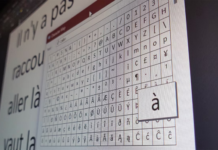Here we can see, “Mac Accessibility Shortcuts: Navigate Your Mac Without a Mouse”
Here are all the shortcuts you’ll need if you’ve activated your Mac’s accessibility capabilities.
You can use a keyboard or an assistive device to control and navigate your Mac if you enable the accessibility features of your Mac.
You can accomplish a lot on your Mac without using a mouse, whether it’s going between menus, adjusting the zoom, or enabling VoiceOver.
We’ve put together a helpful cheat sheet with all of the shortcuts you’ll need to use the accessibility features on your Mac.
Mac Accessibility Shortcuts
| Shortcut | Action |
|---|---|
| Control accessibility options | |
| Option + Command + F5 | Show accessibility options |
| Command + F5 | Enable/disable VoiceOver |
| Control + Option + F8 | Show VoiceOver utility |
| Option + Command + 8 | Enable/disable zoom |
| Option + Command + Plus | Zoom in |
| Option + Command + Minus | Zoom out |
| Control + Option + Command + 8 | Invert colors |
| Control + Option + Command + Period | Increase contrast |
| Control + Option + Command + Comma | Reduce contrast |
| Use your keyboard as a mouse (must be enabled via System Preferences) | |
| Control + F7 | Switch between navigation controls |
| Tab | Next control |
| Shift + Tab | Previous control |
| Control + Tab | Next control when a text field is selected |
| Control + Shift + Tab | Move focus to the previous grouping |
| Arrow keys | Move to the adjacent item |
| Control + Arrow keys | Move to a control adjacent to the text field |
| Space | Choose menu item |
| Return | Default action |
| Esc | Cancel |
| Control + Shift + F6 | Focus on previous panel |
| Control + F8 | Status menu |
| Command + ` | Next open window |
| Shift + Command + ` | Previous open window |
| Option + Command + ` | Window drawer |
| Control menus (press Control + F2 first) | |
| Left/right arrow | Move between menus |
| Type menu item’s name | Move to a menu item |
| Up/down arrow | Move between menu items in the selected menu |
| Return | Open/choose selected menu |
| Mouse Keys (must be enabled via Accessibility Shortcuts) | |
| 8 | Up |
| 2 | Down |
| 4 | Left |
| 6 | Right |
| 1 | Diagonally down and left |
| 3 | Diagonally down and right |
| 7 | Diagonally up and left |
| 9 | Diagonally up and right |
| 5 | Press mouse button |
| 0 | Hold mouse button |
| Period | Release mouse button |
Mac Features for Hearing-Impaired Users
If you use your Mac in accessibility mode, you should be aware of all the hard-of-hearing users’ capabilities. Closed captioning, Siri integration, and the option to flash the screen when an alarm is received are available features.
Conclusion
I hope you found this information helpful. Please fill out the form below if you have any queries or comments.
User Questions:
- How do you move the mouse on a Mac computer?
If you have a numeric keypad, press the “8” key to raise the Mac mouse slightly. The mouse will go down if you press the “2” key, while the “4” and “6” keys will move it left and right, respectively.
- If you don’t have a mouse, how do you click on something?
Fortunately, Windows provides a universal keyboard shortcut that performs a right-click wherever the pointer is. Shift + F10 is the key combination for this shortcut.
- How do you use a Mac Pro to left-click?
Select System Preferences > Mouse > primary mouse button from the drop-down menu. Next to the Left, select the radio button. The left position of your mouse will now be the immediate click area.
4. BetterTouchTool is one of the most worth-it applications to pay. You can replace multiple apps with it (and save some money). Here’s how I use it
BetterTouchTool is one of the most worth-it application to pay. You can replace multiple apps with it (and save some money). Here’s how I use it from MacOS
- TIL “Secret” Shortcut Keys in Mission Control & Keyboard Settings
TIL "Secret" Shortcut Keys in Mission Control & Keyboard Settings from mac



